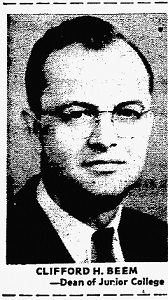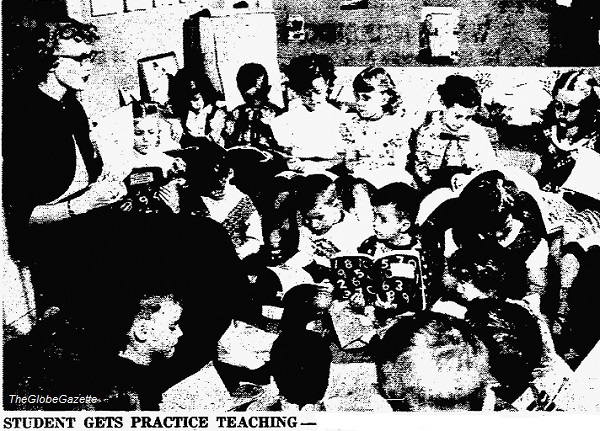|
The Globe Gazette
Mason City, Cerro Gordo County, Iowa
Monday, June 01, 1953
Section 9, Page 15
* * * * * * * * * * * * * * * * * * * * * * * * *
THE STORY of THE SCHOOLS
* * * * * * * * * * * * * * * * * * * * * * * * *
Mason City Junior College First in Iowa
By Clifford H. Beem
Dean of the Junior College
Returning the Roosevelt elementary school building to use as a college, for which purpose it was originally built [Memorial University], is the future planning of
the Mason City school system. This was the recommentation of the citizens study committee and at present [1953] the school board is studying the matter.The
placement of the Junior College in a separate building has been a part of the long-term planning of the schools system for years. The Roosevelt building
was erected to be the first unit of a large plant of the newly organized Memorial College, a dream that was never realized.
Mason City Junior College First in Iowa
By Clifford H. Beem
Dean of the Junior College
 The Centennial Year for Mason City is the 35th year for Mason City Junior College.
The Centennial Year for Mason City is the 35th year for Mason City Junior College.When this college was established there were only
46 Junior Colleges in the United States. Today there are 586. There were 4,504 students enrolled in American Junior Colleges. After only 35 yars there are
over 600,000 Junior College students. The Mason City Junior College was the first public Junior College in Iowa. Today there are 15 public Junior College
and Keokuk is establishing one next fall. This is the most rapidly growing division of the American school system. Former President Conant of Harvard, int the
1952 spring issue of "What the Colleges Are Doing," advised, "Do not expand the four year programs in state universities, rather contract them. Make
a two year college course fashionable." On July 22, 1950, Dwight D. Eisenhower, then president of Columbia University said, "I am strong for President
Conant's idea that the terminal two year college, supported by public taxes, be developed and expanded on a broad democratic base." Ex-President Wilbur
of Stanford University has said, "We can look upon the Junior College movement which is now spreading throughout the United States as the most significant
occurrence in American education in the present century." Gives College PurposeThe original purpose of the Junior College
as stated in one of the earliest catalogs was as follows: "The Mason City Public Junior College aims to give two years of advance study beyond an accredited
high school. Work of acceptable college grade is maintained. The college department extends the public school course two years." There are five specific
objectives of public Junior Colleges today. First, to provide the first two years of a four year college course for those who wish to transfer to a
college or university after completing the two years offered in a Junior College. This training should include what is usually given in the first two
years of a liberal arts college, and should include the courses which are the pre-requisites for entering the professional schools.
Covers Several FieldsSecpmd. special terminal education for those who will complete their formal education in the Junior
College. There should be courses especially planned for those who plan to enter business, a group which has increased more rapidly in recent years than any
other social economic group. There should be special training for the semi-skilled workers, another group which has increased rapidly since 1930. Workers
in these two fields can complete their training in the two years of Junior College and go directly to their jobs. There should be short courses in
general agriculture, home making, and family relationships, home nursing and child care; and merchandising. These terminal courses should not only train
for occupational competence, but also for civic responsibility and personal adequacy. It is in the field of terminal educaiton that the great mission
of the Junior College lies. Third, every Junior College student should be given adequate training in those things which will prepare him to function
effectively as a member of a family, a community, a nation, and a world. Guidance ProvidedFourth, orientation and guidance
is a fundamental purpose of the Junior College. The Junior College, because of smaller classes, can establish a more intimate relationship between
students and teachers than is possible in large schools. It is the reponsibility of the Junior College to help the student to discover his aptitudes, his
abilities, and his special interests, in order that he may intelligently choose his life work and prepare for the successful pursuit of his chosen profession.
Fifth, it is in the field of adult education that Junior Colleges are making their most rapid expansion. The Mason City Junior College has this year
enrolled more than 1800 students in its adult education program. We are living in
a period when people of all ages attend school. Every Junior College should co-operate with every other educational agency in the community in providing
instruction to meet the needs of adults living in the vicinity of the college. Courses should be provided which will include cultural vocational
and recreational education. The Junior College is a nation-wide movement to establish systems of community colleges within commuting distance of the
entire population. These community colleges have as their purpose meeting the educational needs of all people of post high school age.
NOTE: Clifford H. Beem, the only child of Ezra Delany & Ora E. (Harnett) Beem, was born January 2, 1901, Marion County, Iowa.
He received his B.A. degree from Drake University in 1924 and his M.A. degreefrom the U of I in 1931. During the period of his administration at Mason City
Junior College, the institution grew from 200 local-area students to 1,285 students from throughout the state and from other states and countries.
The Beem Center, built in 1977, is named after Clifford H. Beem, who was known as “Mr. Junior College” throughout Iowa for his
leadership with junior college efforts locally and beyond. Beem was named Dean of Mason City Junior College in 1947. When Mason City Junior College
became North Iowa Area Community College in 1966, “Dean Beem” became the Director of Arts and Sciences. He retired in 1970 after 46 years in education.
Dean Beem died at the age of 82 years in December of 1984, Mason City, Iowa. He was interred at Pleasantville Cemetery, Pleasantville Township, Marion County, Iowa.
His legacy lives on through the Clifford H. Beem Memorial Fund, which provides student scholarships annually through the NIACC Foundation.

Phyllis Myli, Junior College sophomore, who will graduate from the teachers training course, is shown above teaching the first grade at the Harding
School to meet the practice teaching requirements of the course.
Shown in the Junior College chemistry laboratory from left are Garry Fristh, with centrifuge, Jim Paxton, Jack Kartel, Dave Hampton, John Chambers and
Jay Allen.
Given Practical Training in U.S. Junior Colleges
That the Junior College is having an increasingly important part in American education is the view of William Pearson Tolley, chancellor of Syracuse University.
"In the beginning it was by no means clear that a two-year post high school program was long enough for the wide variety of technical and vocational
programs the Junior College began to offer," he wrote in The Junior College Journal The success of the Junior College in providing practical
training is now securely established in American higher education, the Syracuse educator stated. "This significant achievement took place at the same
time industrial and military agencies were finding their own answers to the need for specialists and technicians," he added. "The on the job training
programs of industry have now achieved prestige, strength and size undreamed of 20 years ago."
* * * * * * * * * * * * * * * * * * * * * * * * *
Photographs courtesy of Globe-Gazette unless otherwise noted
Some of the photographs did not scan well. In such a case the photograph
has been substituted with a clearer copy if available.
Transcriptions and Note by Sharon R. Becker, August of 2015
Information obtained in notes from other Globe-Gazette articles
| 

